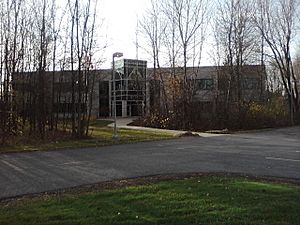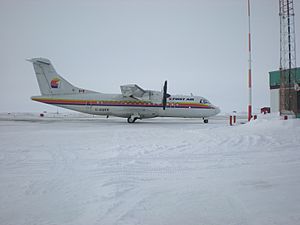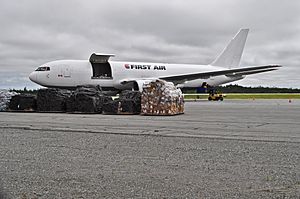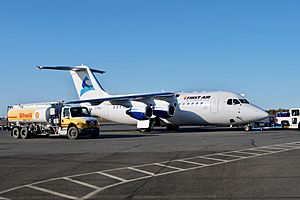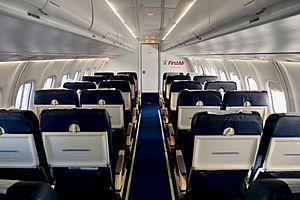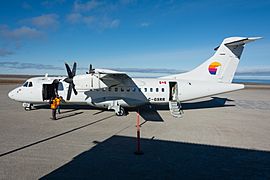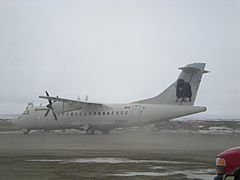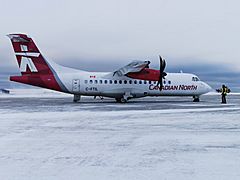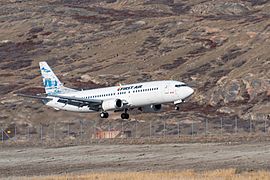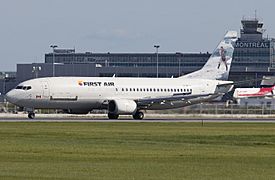First Air facts for kids
 |
|
| Founded | 1946 |
|---|---|
| AOC # | Canada: 107 United States: KBJF476F |
| Hubs | Yellowknife Airport, Iqaluit Airport Rankin Inlet Airport |
| Frequent-flyer program | Aeroplan |
| Fleet size | 31 |
| Destinations | 35 |
| Headquarters | 20 Cope Drive, Kanata, Ontario |
| Key people | Chris Avery President & CEO Alexandra Pontbriand VP Finance Rashwan Domloge VP Maintenance Aaron Speer VP Flight Operations Andrew Pope VP Commercial |
| Website | (redirects to Canadian North) |
First Air was a Canadian airline that helped connect many communities in the northern parts of Canada. Its main office was in Kanata, Ontario, which is a suburb of Ottawa.
First Air flew to 34 different places in Nunavut, Nunavik (in Quebec), and the Northwest Territories. It also helped with important missions, like bringing supplies and equipment during the 2010 Haiti earthquake. The airline's main base was at Ottawa Macdonald–Cartier International Airport. It also had important hubs at Iqaluit Airport and Yellowknife Airport.
On November 1, 2019, First Air joined with another airline called Canadian North. Now, they operate together under the Canadian North name.
The Story of First Air
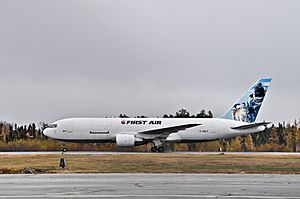
First Air started a long time ago in 1946. It was founded by a Canadian aviation pioneer named Russel (Russ) Bradley. Back then, it was known as Bradley Air Services. The company still uses that name for some official things.
First Air began flying regular passenger flights in 1973. Its first route was between Ottawa and North Bay, Ontario. This flight used a small plane that could carry eight passengers.
The airline grew and opened more routes from cities like Edmonton, Winnipeg, Montreal, and Ottawa. It connected 26 Inuit communities in Nunavut, Nunavik, and the Northwest Territories. First Air even worked with Air Inuit to offer flights to Sanikiluaq, Nunavut.
In the 1990s, First Air grew by taking over two other airlines: Ptarmigan Airways in 1995 and Northwest Territorial Airways (also called NWT Air) in 1997. These airlines became part of First Air.
- Ptarmigan Airways flew smaller planes like the Beechcraft King Air and DHC-6 Twin Otter.
- NWT Air had Boeing 737-200 jetliners and a Lockheed L-100 Hercules cargo plane.
The Makivik Corporation, which represents the Inuit people of Quebec, bought First Air in 1990. This meant the airline was owned by the Inuit community.
Changes and Growth
Over the years, First Air made many changes to its leadership and planes.
- In 2009, First Air got a larger cargo plane, a Boeing 767-223 SF (Super Freighter). This plane helped them carry more goods.
- They later replaced older planes like the Boeing 727-233 with newer, more efficient ones like the ATR 72 Combi turboprops. These new planes could carry both passengers and cargo, which was very helpful for remote communities.
In 2011, First Air worked with other groups to create new airlines.
- Qikiqtani First Aviation was started with Qikiqtaaluk Corporation (QC). It served the Qikiqtaaluk Region of Nunavut.
- Sakku First Aviation was started with Sakku Investments Corporation. It served the Kivalliq Region of Nunavut.
Merger with Canadian North
In 2014, First Air and Canadian North talked about merging. The idea was to create a stronger airline that could offer better service in the North. However, this merger did not happen at that time. They did agree to share some flights instead.
In 2016, First Air became the oldest airline in Canada still operating under its original name, Bradley Air Services.
Finally, in 2018, the owners of First Air and Canadian North signed an agreement to merge. The new airline would be called "Canadian North" but would use the First Air colors and logo. The Canadian government approved the merger in 2019.
On November 1, 2019, First Air and Canadian North officially merged. Now, all flights operate under the Canadian North name.
Where First Air Flew

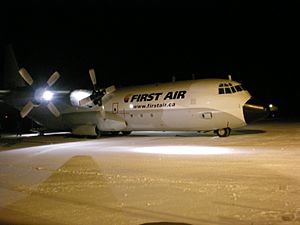
First Air flew to many places across Canada. Here are some of the cities and airports it served:
| City | Province | IATA | ICAO | Airport | Notes |
|---|---|---|---|---|---|
| Arctic Bay | Nunavut | YAB | CYAB | Arctic Bay Airport | |
| Arviat | Nunavut | YEK | CYEK | Arviat Airport | Shared flights with Calm Air |
| Baker Lake | Nunavut | YBK | CYBK | Baker Lake Airport | Shared flights with Calm Air |
| Cambridge Bay | Nunavut | YCB | CYCB | Cambridge Bay Airport | |
| Cape Dorset | Nunavut | YTE | CYTE | Cape Dorset Airport | |
| Chesterfield Inlet | Nunavut | YCS | CYCS | Chesterfield Inlet Airport | Shared flights with Calm Air |
| Churchill | Manitoba | YYQ | CYYQ | Churchill Airport | Shared flights with Calm Air |
| Clyde River | Nunavut | YCY | CYCY | Clyde River Airport | |
| Coral Harbour | Nunavut | YZS | CYZS | Coral Harbour Airport | Shared flights with Calm Air |
| Edmonton | Alberta | YEG | CYEG | Edmonton International Airport | |
| Fort Simpson | Northwest Territories | YFS | CYFS | Fort Simpson Airport | |
| Gjoa Haven | Nunavut | YHK | CYHK | Gjoa Haven Airport | |
| Hall Beach | Nunavut | YUX | CYUX | Hall Beach Airport | |
| Hay River | Northwest Territories | YHY | CYHY | Hay River/Merlyn Carter Airport | |
| Igloolik | Nunavut | YGT | CYGT | Igloolik Airport | |
| Inuvik | Northwest Territories | YEV | CYEV | Inuvik (Mike Zubko) Airport | |
| Iqaluit | Nunavut | YFB | CYFB | Iqaluit Airport | A main hub |
| Kimmirut | Nunavut | YLC | CYLC | Kimmirut Airport | |
| Kugaaruk | Nunavut | YBB | CYBB | Kugaaruk Airport | |
| Kugluktuk | Nunavut | YCO | CYCO | Kugluktuk Airport | |
| Kuujjuaq | Quebec | YVP | CYVP | Kuujjuaq Airport | |
| Montréal | Quebec | YUL | CYUL | Montréal–Pierre Elliott Trudeau International Airport | |
| Naujaat | Nunavut | YUT | CYUT | Naujaat Airport | Shared flights with Calm Air |
| Ottawa | Ontario | YOW | CYOW | Ottawa Macdonald–Cartier International Airport | Cargo hub and maintenance base |
| Pangnirtung | Nunavut | YXP | CYXP | Pangnirtung Airport | |
| Pond Inlet | Nunavut | YIO | CYIO | Pond Inlet Airport | |
| Qikiqtarjuaq | Nunavut | YVM | CYVM | Qikiqtarjuaq Airport | |
| Rankin Inlet | Nunavut | YRT | CYRT | Rankin Inlet Airport | A main hub |
| Resolute | Nunavut | YRB | CYRB | Resolute Bay Airport | |
| Taloyoak | Nunavut | YYH | CYYH | Taloyoak Airport | |
| Ulukhaktok | Northwest Territories | YHI | CYHI | Ulukhaktok/Holman Airport | |
| Whale Cove | Nunavut | YXN | CYXN | Whale Cove Airport | Shared flights with Calm Air |
| Whitehorse | Yukon | YXY | CYXY | Erik Nielsen Whitehorse International Airport | Shared flights with Air North |
| Winnipeg | Manitoba | YWG | CYWG | Winnipeg James Armstrong Richardson International Airport | Shared flights with Calm Air |
| Yellowknife | Northwest Territories | YZF | CYZF | Yellowknife Airport | A main hub |
First Air also had codeshare agreements with other airlines. This means they shared flights and sold tickets for each other's planes. These partners included:
- Air Greenland
- Air North
- Calm Air
- Canadian North (this agreement ended before the merger)
First Air's Planes
As of January 2022, Bradley Air Services (First Air's official name) had 31 aircraft registered in Canada. All these planes are now operated by Canadian North.
Types of Planes First Air Used
Planes First Air Used to Fly
First Air used to fly many different types of planes. Some of these older planes included:
- Boeing 727-100 (could carry both passengers and cargo)
- Boeing 727-200 (both passenger/cargo and pure cargo planes)
- Boeing 737-200 (both passenger/cargo and pure cargo planes)
- Boeing 767-200 (cargo planes)
- de Havilland Canada DHC-6 Twin Otter (could take off and land in short distances)
- Douglas DC-3
- Hawker Siddeley HS 748 (could carry both passengers and cargo)
- Lockheed L-100 Hercules (cargo planes)
- ATR 72-202 (could carry both passengers and cargo)
Incidents and Accidents
Over its history, First Air had some incidents and accidents. Five of these involved fatalities.
- On January 28, 1974, three planes were destroyed in a hangar fire at Carp Airport, Ottawa.
- On August 23, 1978, a de Havilland Canada DHC-6 plane was destroyed near Frobisher Bay (now Iqaluit). One crew member died.
- On August 29, 1979, another de Havilland Canada DHC-6 plane crashed near Frobisher Bay (now Iqaluit). Two crew and seven passengers died.
- On March 15, 1981, a de Havilland Canada DHC-6 plane sank through polar ice near Nord, Greenland.
- On September 15, 1988, a Hawker Siddeley HS 748 plane crashed near Hammond, Ontario, while approaching Ottawa International Airport. Both crew members died.
- On January 12, 1989, another Hawker Siddeley HS 748 plane crashed near Dayton, Ohio, killing both crew members.
- On August 12, 1996, a de Havilland Canada DHC-6 plane was destroyed near Markham Bay, Northwest Territories. Both crew members died.
- On December 3, 1998, a Hawker Siddeley HS 748 plane was badly damaged during takeoff at Iqaluit. All four crew and three passengers survived.
- On May 22, 2001, a Boeing 737-210C plane was badly damaged after landing in Yellowknife. All 98 passengers and 6 crew members survived.
- On August 20, 2011, Flight 6560, a First Air Boeing 737-210C plane, crashed while approaching Resolute. 12 people died, and 3 others were injured.
See also
 In Spanish: First Air para niños
In Spanish: First Air para niños
- Above&Beyond
- List of defunct airlines of Canada



